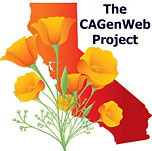Ranchos of California
The Spanish and later Mexican governments encouraged settlement of Alta California (now known as California) by giving prominent men large land grants called ranchos, usually two or more square leagues, or 35 square kilometres (14 sq mi). Land-grant titles were government-issued, permanent, unencumbered property-ownership rights to land called ranchos.
Devoted to raising cattle and sheep, the owners of the ranchos attempted to pattern themselves after the landed gentry of Spain. Their workers included Californian Native Americans who had learned to speak Spanish, many of them former Mission residents.
Spain made about 30 grants between 1784 and 1821, and Mexico granted about 270 more between 1833 and 1846. The ranchos established land-use patterns and place names that are still in use in California today. Rancho boundaries became the basis for California's land survey system, and can still be found on modern maps and land titles.
Source: Ranchos of California on Wikipedia.
Spanish Grants in San Luis Obispo County
The following is a list of the grants made in San Luis Obispo County. A few Spanish grants were made prior to the secularization of the missions, but the most were made later by the Mexican government. By the treaty with Mexico, the landholders were guaranteed their possessions. A commission was appointed to hear testimony and settle claims. The decision of the commission might be appealed to the United States District and Supreme courts. In many cases long litigation followed the commission’s decisions, and often the costs of the suits ate up the land in question. Taking the San Miguel Mission lands, they were divided into the Ascunsion rancho of 39,224.81 acres, and the Atascadero, 4,348.23 acres. These were at one time owned by Martin Murphy, and later by his sons, P. W. and James Murphy. P. W. Murphy also owned the Santa Margarita ranch, in all about 70,000 acres, in this county, and the Cojo ranch of 9,000 acres in Santa Barbara county. The Cholame grant of 13,919.82 acres was given to Mauricio Gonzalez. The Santa Ysabel, 17,774.12 acres, was granted to Francisco Arce; the Huer-Huero, to Jose Mariano Bonilla, 15,684.95 acres. Paso de Robles grant, 25,993.18 acres, became the property of James and Daniel Blackburn and D. L. James, a brother-in-law of the Blackburn brothers. Piedra Blanca, 48,805.59 acres, was granted to Jose de Jesus Pico. Later owners were Juan Castro, heirs of Mariano Pacheco, and Peter Gillis. At present this and the Santa Rosa grant are owned by W. R. Hearst and are known as the Hearst Ranch. One of Mr. Hearst’s vaqueros, it is said, is the son of Julian Estrada, who once owned the Santa Rosa grant and lived in feudal style. This ranch controls almost fifteen miles of seacoast and the fine harbor of San Simeon bay, where large seagoing vessels can and do anchor at the wharf. The San Simeon grant of 4,468.81 acres was granted to Jose Ramon Estrada; San Geronimo, 8,893.35 acres, was granted to Rafael Villavicencio; Morro y Cayucos [Moro y Cayucos], 8,845.49 acres, to Martin Olivera and Vicente Feliz; San Bernardo, 4,379.43 acres, to Vicente Canet; San Luisito, 4,389.13 acres, to Guadalupe Cantua; Cañada del Chorro, 3,160.99 acres, to John Wilson and James Scott; El Chorro or Huerta de Romualdo, 117.13 acres, to an Indian, Romualdo, but it soon passed to another person; Cañada de Los Osos, 32,430.70 acres, to Victor Linares, Francisco Badillo, James Scott and John Wilson.
Potrero de San Luis Obispo, containing 3,506.33 acres, went to Maria Concepcion Boronda; Santa Fe, 156.76 acres, to Victor Linares; La Laguna, one league mission land, 4,157.02 acres, confirmed to Archbishop Joseph Sadoc Alemany; San Miguelito, 22,135.89 acres, to Miguel Avila; Corral de Piedra, 30,911.20 acres, to Jose Maria Villavicencio; Pismo, 8,838.89 acres, to Isaac J. Sparks; Arroyo Grande or San Ramon, 4,437.58 acres, to Zeferino Carlon; Santa Manuela, 16,954.83 acres, to Francis Z. Branch; Balsa de Chemisal [Bolsa de Chamisal], 14,335.22 acres, to Francisco Ouijada; Nipomo grant of 37,887.91 acres, to William G. Dana.
Suey was granted to Ramona de Carillo Wilson; the entire ranch contained 48,234.77 acres, 24,497 acres lying in this county and the remainder in Santa Barbara county. Huasna, 22,152.99 acres, was given to Isaac J. Sparks; Tepesquet [Tepusquet], 2,950 acres in San Luis Obispo County, and 5,950.75 acres in Santa Barbara county, to Tomas Olivera; Santa Margarita, 17,734 acres, to Joaquin Estrada; Atascadero, 4,348.23 acres, to Triphon Garcia; Ascunsion [Asuncion] 39,224.81 acres, to Pedro Estrada; Paso de Robles, 25,993.18 acres, to Pedro Narváez; Mission San Luis Obispo, 52.72 acres, to Catholic Church; lot in Mission San Luis Obispo, one acre, to John Wilson. The public library of San Luis Obispo now stands on that lot.
In the majority of cases these great grants were literally sold for a song to the American settlers when they came in. At the present time only a very few are held in part by the heirs of those who received the grants. The Huasna rancho was divided by Mr. Sparks among his three daughters, Mrs. Flora Harloe, Mrs. Rose Porter and Mrs. Sallie Harkness. These ladies either still own part of their inheritance, or held it until it commanded a good price. The Nipomo grant was subdivided among the heirs of William G. Dana, and some of his sons still own portions of it. Members of the Branch family still own a small portion of the Santa Manuela and Arroyo Grande ranches. So far as can be learned, all the other great grants have passed out of the possession of the original holders.
About fifteen years ago the grandson and granddaughter of Jose Maria Villavicencio, known as Villa, found and homesteaded a piece of government land in the hills back of Nipomo. The granddaughter is a teacher in the county, a fine woman, who, with her brother, has for years made a comfortable home for their mother. This mother as a girl dressed in silks and wore her satin dancing slippers. As a wife and mother she toiled on a little ranch to raise the family, and saw others grow rich and live in luxury on the lands of the Corral de Piedra that her father sold for so little. No wonder some of these Spanish women of the olden days refuse to speak the language of the Americans. To them the Americans spelled ruin, and their girlhood memories were embittered because their Spanish fathers were not able to cope with the keen Yankee business of the “Gringos.”
Source: History of San Luis Obispo County and Environs, California, by Annie L. Morrison and John H. Haydon, 1917, pp51-52. Transcribed for the CAGenWeb Project by Cathy Portz.
Mexican Land Grants diagram on Old MorroBay.com.
Land Grants, Patents and Ranchos data on the San Luis Obispo County Genealogical Society website.
Index to Federal Land Records for San Luis Obispo County
Listed alphabetically by last name:
- Abbbott–Byer
- Clarke–Custro
- DaCosta–Exline
- F A Hyde–Guy
- Hackney–Kusta
- Laflin–Myers
- Najar–Quintes
- Rackliffe–Szabo
- Tackabury–Zunni
You can order a copy of land patents through the California Bureau of Land Management office in Sacramento, or online through the General Land Office website where you can search for Land Records.
The National Archives Land Entry Records also has information and links to resources on land entry case files and related records.
See the Resources page on the Los Californianos website for information on their genealogical research with original sources, copies of land grants they provide at a nominal fee, and services to vet historical and genealogical material they offer. Los Californianos was organized by the descendants of California’s early Hispanic settlers to preserve the Hispanic heritage of Alta California (history, music, culture, infrastructure, etc.) and to help other descendants compile their Hispanic genealogy.

